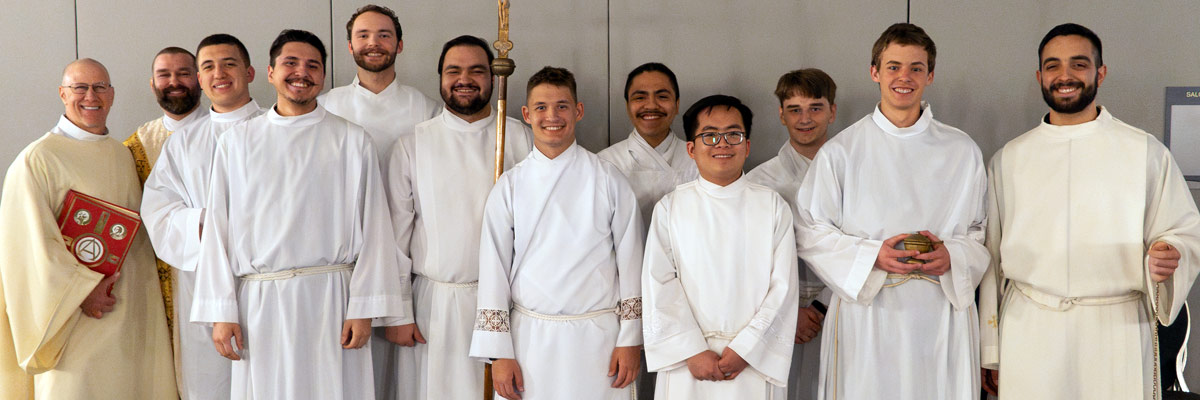Official Website of the
Catholic Diocese of Little Rock
Jesus draws followers, upsets opponents
Published: June 19, 2010
This is the third column in a 13-part series
By Clifford M. Yeary
Associate Director, Little Rock Scripture Study
Russian novels by Tolstoy, Dostoevsky and others can be a great, but very long read. They are filled with so many characters that it is sometimes difficult for readers to tell them apart, or to remember who is who in the story. For someone who has not been a real student of the Gospels, they too can pose a challenge. Who and what are the disciples? Are they the same as the apostles? What about these scribes and Pharisees, and who are the Sadducees?
 Jesus was very controversial. He attracted ardent followers, but there were many who opposed him. His opponents are often identified only by their association with a certain group or party. Except for key political and religious opponents, most individuals named in the Gospels tend to be followers of Jesus.
Jesus was very controversial. He attracted ardent followers, but there were many who opposed him. His opponents are often identified only by their association with a certain group or party. Except for key political and religious opponents, most individuals named in the Gospels tend to be followers of Jesus.
Jesus’ earliest followers are called disciples, a name that we hopefully have kept alive and own for ourselves as Christians. A select group of Jesus’ disciples were named by him as apostles.
An apostle is someone (one of only 12) Jesus personally chose and sent out from him with a special message, the good news of God’s coming reign over human affairs being very close at hand (Matthew10:1-11). While only disciples were chosen to be apostles, whether every disciple was also one of the 12 apostles depends on the Gospel you are reading.
In Matthew, the apostles are called the 12 disciples (Matthew 11:1). Matthew also limits the term “disciple” to these apostles, who Matthew only calls apostles once (Matthew 10:2). In Luke, however, there are at least 70 others who are considered disciples (Luke 10:1), and by the time of his triumphal entry into Jerusalem, he is said to have a multitude of disciples (Luke 19:37). If Christians consider themselves disciples without fear of being confused with being an apostle, we owe it to Luke.
Among the religious leaders of Jesus’ time, the most frequently mentioned are scribes, Pharisees and Sadducees.
The scribes were the Bible scholars of their time. They were responsible for interpreting the Law of Moses (see Matthew 23:2) and they often did so by recording the valued opinions of predecessors and carefully weighing and balancing their opinions on any disputed matter of the Law. It might be that their reputation for giving careful, nuanced interpretations led to the amazement at the straightforward authority with which Jesus taught (Mark 1:22).
While scribes are often depicted as opponents of Jesus, there were exceptions. At some point some scribes must have brought their expertise with Scripture with them as they became followers of Christ. Jesus proclaims in Matthew that, “Every scribe who has been instructed in the kingdom of heaven is like the head of a household who brings from his storeroom both the new and the old” (Matthew 13:52). A scribe who believed in Christ would find many “new” things in Scripture that a scribe who rejected Jesus would not.
The scribes often tended to be associated with another party, the Pharisees, but not all Pharisees were scribes and not all scribes would have been Pharisees. The Pharisees were Jews who were striving for personal holiness by careful observance of Mosaic Law.
The scribes had serious problems with Jesus forgiving sins (Matthew 9:2-6) and the Pharisees were shocked at his willingness to associate with known sinners (Matthew 9:9-13). The priests of the Temple, their families and supporters had their own religious party, the Sadducees, and they had their own problems with Jesus. The Pharisees and scribes interpreted the Law of Moses for daily life in human society, and struggled with how to respond to the Roman occupation of Israel. The Sadducees, however, had compromised with the Roman authorities in order to be left free to conduct their priestly duties in the Temple.
The Sadducees, unlike the scribes and the Pharisees, did not accept as Scripture any of the prophets or the Psalms. It was from these writings that many Jews drew their expectation of a political liberator, a messiah.
The Sadducees apparently feared the followers of Jesus might eventually draw the attention of the Roman authorities if they started hailing him as the Messiah — especially if the Romans understood the desire for a Messiah as a clamoring for revolution.
The Sadducees knew the Roman response would be brutal and their fragile comprise with them might be torn asunder.
The Gospels indicate that all these groups, including one of Jesus’ disciples, conspired together to expose Jesus as a serious threat to Rome, and it was the Roman governor Pontius Pilate that sentenced him to death by crucifixion.
Study Questions
- How do Matthew and Luke portray the role of Apostles and disciples differently?
- What did Jesus do or say that upset the Pharisees and the scribes?
- What made Jesus seem to some to be a political and not just a religious threat?
- Do Jesus’ teachings create opposition today? If so, what are his most controversial teachings?
This article was originally published in Arkansas Catholic June 19, 2010. Copyright Diocese of Little Rock. All rights reserved. This article may be copied or redistributed with acknowledgement and permission of the publisher.









